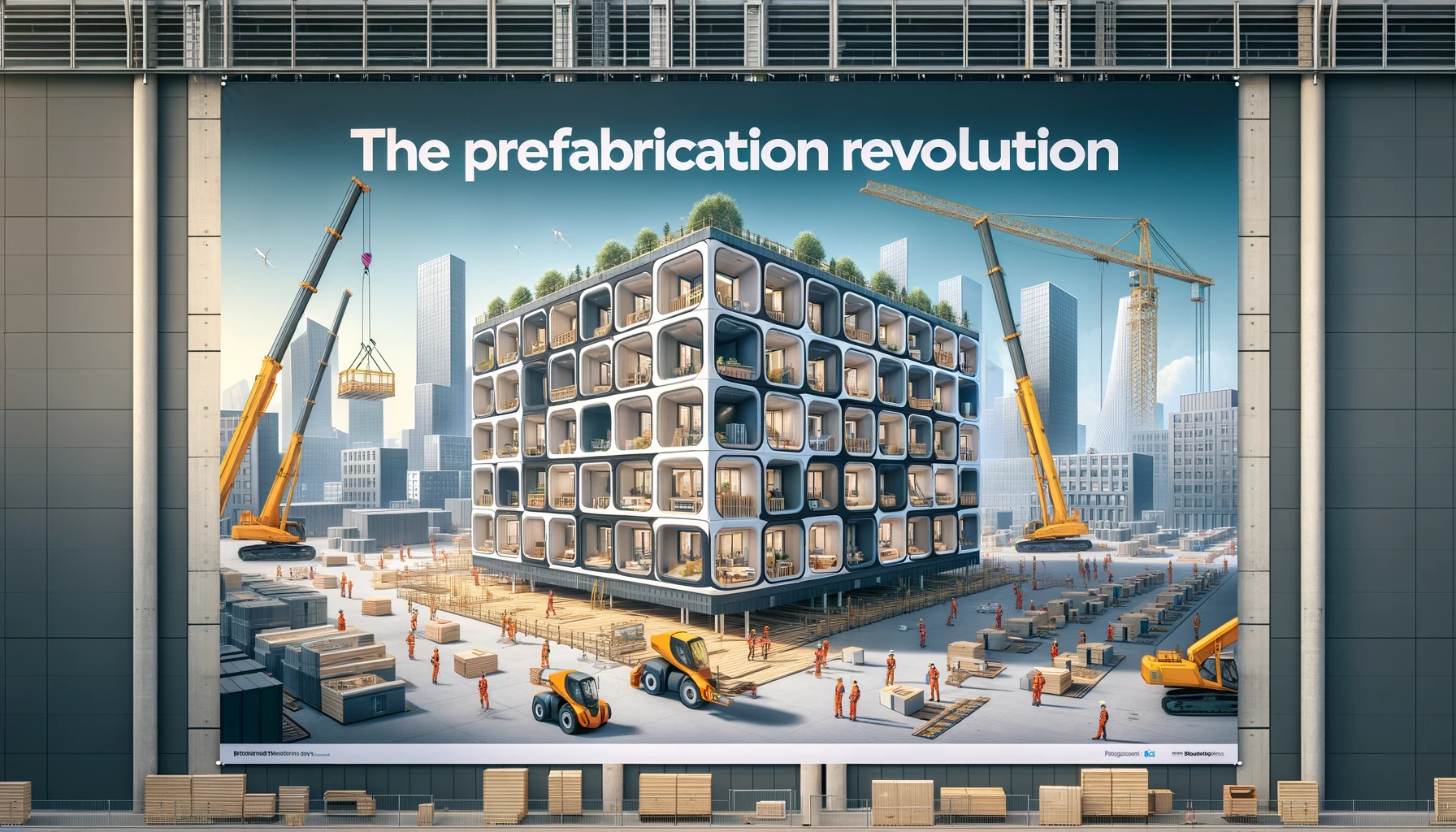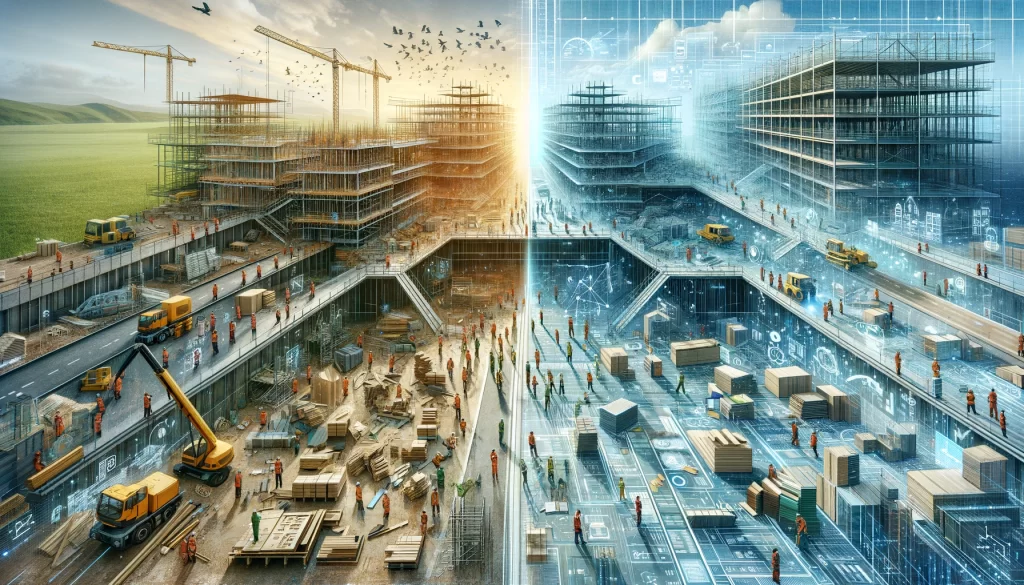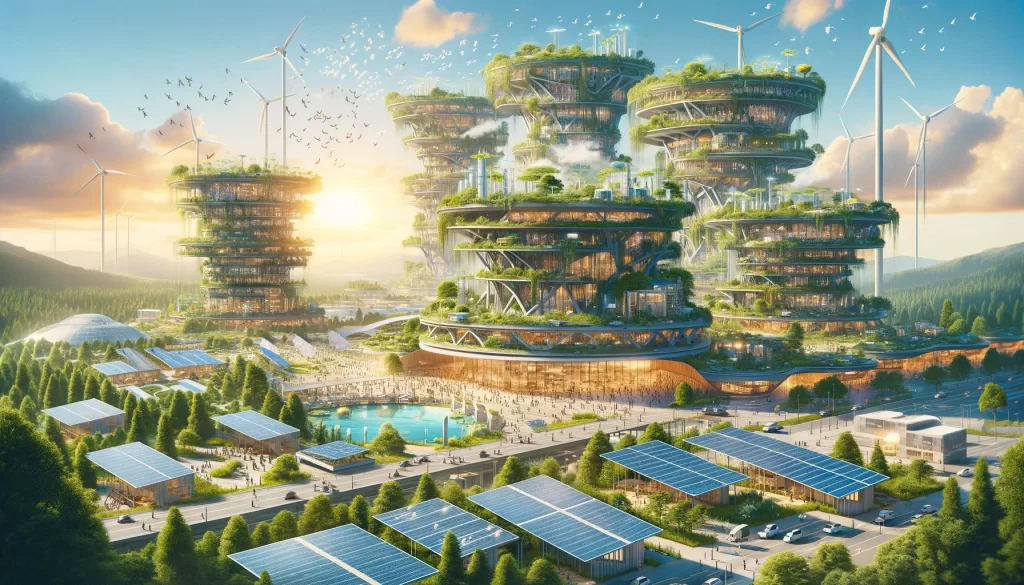
Shaping The Future Of Construction
In the intricate tapestry of construction’s ongoing evolution, offsite construction and prefabrication emerge as not merely vibrant threads but as pivotal forces of change, heralding a new era in the architectural and engineering domains. These methodologies stand distinguished, not solely for their innovative approach but for the profound transformative impact they pledge to the very essence of our built environment. As we navigate deeper into the intricacies of these methods, it becomes unmistakably clear that their significance extends far beyond mere advancements in construction technology; they represent a fundamental paradigm shift in the way we conceptualize, execute, and engage with the spaces around us.
Offsite construction and prefabrication, with their roots entrenched in efficiency and sustainability, are reshaping the landscape of construction into one that is far more attuned to the demands of the modern world. These are not just techniques that streamline processes and reduce timelines; they are visionaries that redefine the boundaries of architectural possibility. They empower us to imagine and create spaces that align more closely with our aspirations for sustainability, adaptability, and harmony with the natural world.
This seismic shift is underpinned by a departure from traditional, on-site construction practices, which are often characterized by prolonged durations, significant waste, and heightened environmental impact. Instead, offsite construction and prefabrication advocate for a smarter, cleaner approach. By transferring much of the building process to controlled factory environments, these methods significantly minimize waste, enhance quality control, and drastically reduce the carbon footprint associated with construction activities.
Moreover, the advent of these methodologies signifies a transformative change in how we interact with our built environment. It paves the way for buildings and structures that are not only constructed more efficiently but are also designed with greater flexibility, resilience, and responsiveness to the needs of their inhabitants. This shift towards a more thoughtful and conscientious approach to construction heralds a future where our built environment does not merely exist but thrives, in a symbiotic relationship with the natural world and the communities it serves.
In essence, the journey into offsite construction and prefabrication is a journey towards reimagining the fabric of our built environment. It invites us to envision a world where every structure is a testament to our collective commitment to innovation, efficiency, and sustainability. As we continue to weave these threads into the broader tapestry of construction evolution, we are not just building for today; we are crafting the legacy of a more sustainable, efficient, and harmonious world for generations to come.
Deep Dive into Offsite Construction and Prefabrication

Imagine embarking on a construction project not with the chaos of a traditional site but with the precision and clarity of assembling a complex masterpiece, much like the high-precision, beloved Lego sets of our childhoods. This is the reality of offsite construction and prefabrication, where every component of a building is meticulously crafted within the controlled confines of a factory setting, far removed from the unpredictable challenges of on-site construction.
This transformative process goes beyond merely assembling parts of a structure in a different location; it represents a fundamental rethinking of how buildings come to life. It’s about envisioning construction through a new lens, where efficiency, precision, and innovation lead the way.
In the realm of offsite construction and prefabrication, buildings are no longer just erected; they are born from a fusion of advanced manufacturing techniques and architectural creativity. Components are not just made; they are engineered with unmatched accuracy, ensuring that every element fits together in perfect harmony, much like the pieces of a meticulously designed puzzle.
The journey of a prefabricated component begins in the calm and precision of the factory, where the tumults of traditional construction sites—such as weather delays, material shortages, and varied craftsmanship—are replaced by a consistent, quality-controlled environment. Here, technology and craftsmanship intertwine, allowing for the production of building elements to standards that onsite construction could only dream of achieving.
But the innovation of offsite construction and prefabrication does not stop at manufacturing. It extends into every phase of the building process, from the initial design where architects and engineers collaborate in a digital landscape, to the final assembly on site, where components seamlessly come together to create structures of enduring strength and beauty.
This approach is not merely about constructing buildings more efficiently; it’s a bold step towards redefining the very essence of how we create spaces. It challenges the conventional, breaks down barriers of what’s possible, and opens up a world of opportunities for design, sustainability, and construction excellence.
As we delve deeper into the world of offsite construction and prefabrication, we discover not just a method of building, but a movement towards a smarter, more sustainable, and incredibly exciting future in construction.

Navigating the Shift
The journey into offsite construction and prefabrication is akin to setting sail into uncharted waters, requiring not just a map and compass, but a fundamental rethinking of the very ship we navigate. This new era of construction is not merely about adopting new tools or techniques; it’s about transforming the core of project management and fostering a culture of innovation and seamless collaboration.
The transition demands a comprehensive overhaul in how projects are conceived, planned, and executed. It’s about building bridges of communication between architects, engineers, contractors, and clients right from the outset, ensuring that every voice is heard and every detail meticulously planned. The blueprint for success in this realm is drawn not just with pen and paper, but with commitment, foresight, and a collective vision.
Central to this collaborative effort is the adoption of digital tools that bring this vision to life. Building Information Modeling (BIM) software emerges not just as a tool, but as a cornerstone of offsite construction and prefabrication. BIM allows for the detailed visualization and planning of every facet of a project, transforming abstract ideas into tangible realities. Through BIM, stakeholders can anticipate and address potential challenges long before construction begins, ensuring that the final assembly on site unfolds with the grace and precision of a well-rehearsed symphony.
But the digital transformation doesn’t stop at modeling and visualization. Platforms that facilitate seamless collaboration become the lifeblood of the project, allowing for real-time updates, feedback, and adjustments. This digital ecosystem supports a level of integration and communication once deemed impossible, ensuring that every stakeholder is continuously aligned with the project’s goals and progress.
Navigating the shift to offsite construction and prefabrication, therefore, is less about steering through technological advancements and more about embracing a new culture of construction—one that values precision, efficiency, and collaboration above all. It’s about recognizing that the strength of a project lies not just in the materials from which it’s built, but in the unity and vision of its creators.
As we chart this course, it becomes clear that the future of construction is not just about buildings that stand taller, but about building practices that are smarter, teams that are tighter, and outcomes that are brighter. The shift towards offsite construction and prefabrication is not just a trend; it’s a transformative journey towards building a better world.
The Unparalleled Advantages

Embarking on an offsite construction and prefabrication journey unveils a realm of unparalleled advantages, each more compelling than the last. This innovative approach to building reshapes timelines, budgets, quality benchmarks, environmental impacts, and safety standards, heralding a new dawn in the construction sector.
Revolutionizing Timelines and Efficiency
The narrative of construction projects is being rewritten with speed and efficiency at its core. Offsite construction transforms years into months, as the simultaneous manufacturing of components alongside site work slashes timelines dramatically. Imagine the metamorphosis of landscapes and cityscapes occurring not in a slow dance, but with the swift precision of a well-orchestrated ballet. This acceleration does not just mean faster project completions; it heralds a new era of productivity and opportunity.
Redefining Cost Effectiveness
At first glance, the initial investment in offsite construction might seem steep. However, delve deeper, and the economic landscape reveals long-term savings too significant to ignore. The reduction in labor costs, the minimization of waste, and the swift project timelines converge to form a trifecta of cost efficiency. This approach not only optimizes financial resources but also maximizes value, ensuring that every dollar spent builds towards a more sustainable future.
Elevating Quality to New Heights
Quality control in offsite construction is unparalleled, thanks to the controlled factory settings where precision reigns supreme. Here, consistency is not a goal but a standard, ensuring each component not only meets but exceeds the highest quality benchmarks. This environment challenges the unpredictability of traditional on-site construction, offering a path where excellence in craftsmanship is a constant, not a variable.
Championing Environmental Stewardship
Offsite construction stands at the forefront of sustainable building practices, steering the construction industry towards a greener, more responsible future. By drastically reducing waste and lowering energy consumption, this approach significantly diminishes the carbon footprint of building projects. It’s a testament to the industry’s capability to innovate not just for efficiency and cost, but for the planet.
Enhancing Safety Across the Board
The shift towards offsite construction brings with it a profound impact on workplace safety. With a reduced need for on-site labor, the potential for accidents dramatically diminishes, fostering a safer environment for construction workers. This focus on safety extends beyond the moral imperative, impacting project timelines and costs positively by reducing delays and financial liabilities associated with workplace accidents.
In summary, the journey into offsite construction and prefabrication is not just an exploration of a new building method—it’s a leap into a future where efficiency, sustainability, and safety are not just envisioned but realized. It’s a testament to the industry’s relentless pursuit of innovation, driving towards a world where the built environment is a reflection of our highest standards and aspirations.

Beyond the Obvious: The Impact on Different Structures
The magic of offsite construction and prefabrication lies in its boundless adaptability, transcending traditional boundaries to reimagine what’s possible across all facets of construction. This isn’t merely about erecting buildings or laying down infrastructure; it’s about forging new paths of innovation that stretch from the heart of bustling cities to the tranquility of residential landscapes, and deep into the veins of our civil lifelines.
Revolutionizing Civil and Non-Civil Realms
In the grand tapestry of civil infrastructure, the precision that prefabrication brings is nothing short of revolutionary. Imagine bridges, tunnels, and public utilities, all taking shape with such exactitude that the environmental footprint and public disturbances are minimized to whispers in the background. These essential structures, the backbone of our daily lives, can now evolve and emerge with minimal disruption, seamlessly integrating into the fabric of our environment.
The realm of non-civil construction, too, finds a vibrant canvas in offsite construction. Here, architects and designers are no longer constrained by the rigidity of traditional building methods. Instead, they are free to explore the depths of their creativity, bringing to life complex and dynamic designs that were once deemed too ambitious. The customization potential of prefabricated elements acts as a key, unlocking doors to architectural marvels that blend form, function, and sustainability in equal measure.
A Catalyst for Creative Liberation
Offsite construction and prefabrication serve not just as methods but as catalysts for creative liberation. They invite a rethinking of space, encouraging the creation of structures that are not only efficient and sustainable but also breathtakingly innovative. In this new era, buildings are more than static entities; they are dynamic expressions of human ingenuity and environmental consciousness.
From the towering skyscrapers that pierce the skyline with their sustainable elegance, to the sprawling residential complexes that offer sanctuaries of green living, and onto the intricate networks of bridges and tunnels that weave through the landscape, offsite construction and prefabrication are laying the foundation for a future where every structure tells a story of advancement, sustainability, and unparalleled creativity.
The Path Forward
As we stand on the brink of this transformative shift, it’s clear that the impact of offsite construction and prefabrication extends far beyond the assembly line. It’s about envisioning and building a world where every structure is a testament to the possibilities that lie at the intersection of technology, sustainability, and visionary design. In this world, every beam, every panel, and every prefabricated element serves as a building block not just for structures, but for a brighter, more sustainable future.
The Road Ahead with GIRHIMPROM's Vision

As we peer into the horizon, the vision of GIRHIMPROM for offsite construction and prefabrication emerges not just as a blueprint for the future but as a manifesto for a revolutionary change. GIRHIMPROM isn’t merely looking towards making construction processes faster and more efficient; it dreams of a symbiosis between the built environment and the natural world. Its deep-seated commitment to scientific inquiry and sustainability makes it an architect of the future, sculpting the evolution of construction methodologies with foresight and ingenuity.
Innovation and Sustainability: The Core of GIRHIMPROM’s Journey
The road that unfolds ahead is brimming with potential, paved with opportunities for groundbreaking innovations and collaborative ventures that redefine what it means to build. GIRHIMPROM stands at the vanguard of this journey, championing a construction ethos where efficiency is intertwined with ecological harmony. The future, as envisioned by GIRHIMPROM, transcends traditional constructs of buildings and infrastructure, aspiring instead to create living ecosystems where nature and human creativity flourish in concert.
This transformative vision positions offsite construction and prefabrication not as fleeting industry trends, but as fundamental shifts towards a more sustainable, efficient, and innovative construction paradigm. In this evolving landscape, GIRHIMPROM’s expertise in scientific research and its unwavering commitment to environmental stewardship act as guiding stars, illuminating the path towards building practices that honor our planet as much as they do our technological ambitions.
Crafting Sustainable Environments: The Collective Endeavor
The call to action is clear and compelling: to join hands with GIRHIMPROM in reimagining the fabric of our built world. This isn’t a journey that GIRHIMPROM undertakes alone; it’s a collective endeavor that beckons every stakeholder in the construction industry to partake in. Together, the aim is not merely to erect structures but to weave the very essence of sustainability into the environments we create.
As we embrace this shared vision, the narrative of construction is being rewritten. The methodologies of offsite construction and prefabrication, championed by GIRHIMPROM, are laying the cornerstone for a future where construction projects are as kind to the earth as they are emblematic of human progress. In this collaborative pursuit, we are not just constructing buildings; we are nurturing the sustainable environments that will cradle the generations to come.
A World Reimagined: The Legacy of GIRHIMPROM
In this pivotal moment in history, GIRHIMPROM’s vision for offsite construction and prefabrication serves as both a challenge and an inspiration. It calls upon us to dream bigger, to push the boundaries of what is possible, and to reimagine a world where our creations and the natural environment exist in harmonious balance. As we move forward, it is this vision that will guide our steps, ensuring that the legacy we leave behind is one of innovation, sustainability, and enduring harmony between humanity and the earth.
